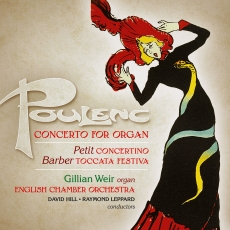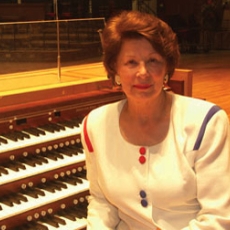Poulenc Organ Concerto - The Absolute Sound
Gillian Weir anchors this splendid SACD with Francis Poulenc's Organ Concerto, which the notes quite correctly point out is the only such work that's heard with any frequency. Dame Gillian has recorded the Poulenc before, in the late 1980s for Virgin. That performance was very fine, but this one's better. After a portentous introduction, Weir, conductor Hill (Raymond Leppard leads the other two works on the disc), and the ECO launch into an energized, headlong Allegro and, despite several luminous slow interregnums, the forward momentum just doesn't quit for 21-plus minutes. The orchestra matches the soloist in phrasing and tone, as when they trade figures in the gently swaying passage that begins about seven minutes into the piece. Weir's playing throughout is sensitively shaped and rhythmically rock-solid.
The program continues with music by Pierre Petit (1922 - 2000), whose day job for a quarter century was music critic for Le Figaro in Paris. Petit's Concertino is a compact yet substantial work in three movements, composed in 1958 for organist Pierre Cochereau. It's harmonically rich and melodically appealing, though more sinewy than the Poulenc; the piece is characteristically French in the clarity of its design and textures. In this company, Samuel Barber's Toccata Festiva sounds idiomatically American, with an open expansiveness and angular lyricism. Sections of tender songfulness set off vigorous, more obviously "toccata-like" parts. The piece is effectively orchestrated and builds to a triumphant conclusion.
Linn's multichannel recording - its first surround release - is remarkably successful. The 1995 Marcusseb organ is located behind the listener in St. Augustine's Chapel at the Tonbridge School (in Kent, England) with the orchestra positioned in front. These two large musical presences convincingly occupy different realms of the same acoustic space: Loud outbursts from the organ decay toward the front of the soundfield and those from the orchestra, towards the rear. There is an utterly natural intelligibility to this recording that is profoundly absorbing. Bass output from the organ's pedal stops is prodigious and the colour, flexibility, and power of the Danish instrument are fully communicated. The 16/44.1 layer sounds very good, as does the two-channel SACD, with excellent blend and balances between the organ and orchestral forces - though you'd never know the real disposition of the musicians from the stereo versions. It's as one of the most musically rewarding implementations of multichannel recording technology yet encountered that this disc truly makes its mark.

